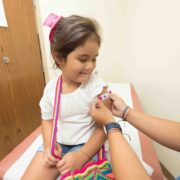
By Jenny Manrique/Ethnic Media Services
Vaccinating 12 to 17 year olds will be one of the great milestones in controlling the COVID-19 pandemic in the U.S., experts speaking on an Ethnic Media Services news briefing agreed.
As many as 22 million children and adolescents, 5 to 17 years, have been infected in the US since the pandemic began, according to estimates by the Centers for Disease Control and Prevention (CDC). COVID-19 now ranks among the 10 leading causes of death for young people who make up 22% of all new COVID cases, compared to only 3% a year ago.
Dr. Grace Lee, Associate Chief Medical Officer for Practice Innovation and Infectious Diseases at Stanford Children’s Health, said infections have increased among children for two fundamental reasons: the reopening of schools and the effectiveness of vaccines in protecting the adult population, which caused a rise in the proportion of reported hospitalizations among children.
“We have had children who died from COVID-19 disease,” Lee said. “Among the hospitalizations we’ve seen in the US, while 60% do have a high-risk condition, including obesity, asthma, developmental delay, immunocompromised, and diabetes, we also know that 40% of those who are hospitalized have no high-risk conditions.”
Lee noted that there is “a disproportionate number” of black and Hispanic children in ICUs, who are also the most affected by MISC (multisystemic inflammatory syndrome in children), which happens approximately two to six weeks after the COVID infection.
The pediatrician added that although children are frequently asymptomatic, they still can transmit the virus to others and vaccinating them makes it easier to extend protection if they have immunocompromised relatives.
Pfizer and Moderna are already conducting trials to identify the correct dose for children under 12 years of age, whose weight and height may determine the response to be different from adults. The most optimistic timeline for extending vaccinations to children is next fall.
Barriers to getting vaccinated
Despite scientific studies, some parents still distrust vaccines or cannot access them. Low-income Hispanic families are primarily fearful of missing work.
“Most of our patients have low-income jobs as day laborers. That’s why it’s a burden for them to take a day off (to get vaccinated),” said Dr. José Pérez, Chief Medical Officer at South Central Family Health Center in Los Angeles, which provides services for 27,000 patients, mostly Latino.
“Our patients are being asked to basically choose between earning a living for the day or vaccinating their children.”
Perez said the county of Los Angeles County has done a great job putting up massive vaccine areas, “but they all require a car and most of our patients use public transportation. So that is an added barrier.”
“Our patients who are undocumented are afraid to use government services for fear of jeopardizing any type of legal immigration status,” Pérez added. They are also frightened by the lack of health insurance, not knowing that vaccines are free and the myths that run on social media, which say, for example, that vaccines cause infertility.
“The role of professionals of color like me becomes very important. I think our patients trust providers who look like them. The more we encourage our patients to get vaccinated, the more likely they are to listen to our voices and not those crazy voices out there in the Internet world.”
When the parents go to his office, Pérez reminds them that they have been “vaccinating their children for a long time” and that they have already had extensive experience with other vaccines against polio, varicella, rubella or the mumps. “COVID vaccines went through the same rigorous scientific testing and evaluation as all other vaccines,” he tells them.
Although the pediatrician recognizes that people cannot be forced to get the vaccine, he believes that the COVID-19 vaccine should be mandatory among children who want to attend public schools. “We don’t have a pandemic in varicella or mumps, or rubella. And the reason for that is that we mandate that our children get vaccinated. This should not be any different.”
Young mothers, the most distrustful
Matthew Simonson, researcher with the Covid States Project and lead author of the report “Vaccinating America’s Youth,” said his research shows that almost a third of young mothers between the ages of 18 and 35 do not want to vaccinate their children. They are resistant even to vaccinating themselves. Fathers, on the other hand, regardless of their age, present between 10% and 15% resistance.
“This gender gap is particularly important because mothers are the ones who are most involved in making these decisions about their children’s health,” said Simonson.
In terms of race, Asian American parents are less resistant to vaccinating their children than other groups, and for the first time African Americans and Latinx are at par with white families regarding hesitancy. “Parents of all races are suspicious of vaccines,” he said. But socioeconomic differences stand out: families earning less than $25,000 a year are the most resistant to vaccines, while those earning more than $150,000 are more likely to get vaccinated. Similarly, those with only a high school diploma are the most vaccine resistant, while those who have a graduate degree favor vaccines.
Simonson highlighted as “encouraging” that surveys of young adults between the ages of 18 and 22 found that they are less hesitant than their parents and are ready to get vaccinated. “So maybe our kids will save us,” he concluded.






